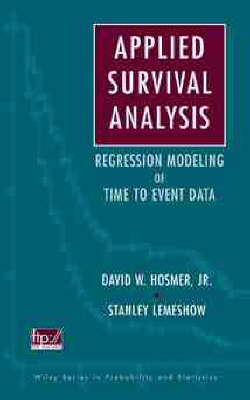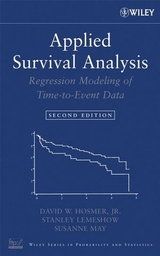
Applied Survival Analysis
Regression Modeling of Time to Event Data
Seiten
1999
John Wiley & Sons Inc (Verlag)
978-0-471-15410-5 (ISBN)
John Wiley & Sons Inc (Verlag)
978-0-471-15410-5 (ISBN)
- Titel ist leider vergriffen;
keine Neuauflage - Artikel merken
Zu diesem Artikel existiert eine Nachauflage
This companion to "Applied Logistic Regression" provides an introduction to the analysis of time-to-event data, with a focus on the health related studies. Emphasis is placed on the modelling of data and the interpretation of results.
A Practical, Up-To-Date Guide To Modern Methods In The Analysis Of Time To Event Data. The rapid proliferation of powerful and affordable statistical software packages over the past decade has inspired the development of an array of valuable new methods for analyzing survival time data. Yet there continues to be a paucity of statistical modeling guides geared to the concerns of health-related researchers who study time to event data. This book helps bridge this important gap in the literature. Applied Survival Analysis is a comprehensive introduction to regression modeling for time to event data used in epidemiological, biostatistical, and other health-related research. Unlike other texts on the subject, it focuses almost exclusively on practical applications rather than mathematical theory and offers clear, accessible presentations of modern modeling techniques supplemented with real-world examples and case studies. While the authors emphasize the proportional hazards model, descriptive methods and parametric models are also considered in some detail. Key topics covered in depth include: Variable selection. Identification of the scale of continuous covariates.
The role of interactions in the model. Interpretation of a fitted model. Assessment of fit and model assumptions. Regression diagnostics. Recurrent event models, frailty models, and additive models. Commercially available statistical software and getting the most out of it. Applied Survival Analysis is an ideal introduction for graduate students in biostatistics and epidemiology, as well as researchers in health-related fields.
A Practical, Up-To-Date Guide To Modern Methods In The Analysis Of Time To Event Data. The rapid proliferation of powerful and affordable statistical software packages over the past decade has inspired the development of an array of valuable new methods for analyzing survival time data. Yet there continues to be a paucity of statistical modeling guides geared to the concerns of health-related researchers who study time to event data. This book helps bridge this important gap in the literature. Applied Survival Analysis is a comprehensive introduction to regression modeling for time to event data used in epidemiological, biostatistical, and other health-related research. Unlike other texts on the subject, it focuses almost exclusively on practical applications rather than mathematical theory and offers clear, accessible presentations of modern modeling techniques supplemented with real-world examples and case studies. While the authors emphasize the proportional hazards model, descriptive methods and parametric models are also considered in some detail. Key topics covered in depth include: Variable selection. Identification of the scale of continuous covariates.
The role of interactions in the model. Interpretation of a fitted model. Assessment of fit and model assumptions. Regression diagnostics. Recurrent event models, frailty models, and additive models. Commercially available statistical software and getting the most out of it. Applied Survival Analysis is an ideal introduction for graduate students in biostatistics and epidemiology, as well as researchers in health-related fields.
DAVID W. HOSMER, Jr., PhD, is a professor of biostatistics in the Department of Biostatistics and Epidemiology of the University of Massachusetts School of Public Health and Health Sciences in Amherst, Massachusetss. STANLEY LEMESHOW, PhD, is a professor of biostatistics in the Department of Statistics at The Ohio State University.
Introduction to Regression Modeling of Survival Data. Descriptive Methods for Survival Data. Regression Models for Survival Data. Interpretation of a Fitted Proportional Hazards Regression Model. Model Development. Assessment of Model Adequacy. Extensions of the Proportional Hazards Model. Parametric Regression Models. Other Models and Topics. Appendices. References. Index.
| Erscheint lt. Verlag | 4.2.1999 |
|---|---|
| Reihe/Serie | Wiley Series in Probability and Statistics |
| Zusatzinfo | Illustrations |
| Verlagsort | New York |
| Sprache | englisch |
| Maße | 160 x 240 mm |
| Gewicht | 680 g |
| Einbandart | gebunden |
| Themenwelt | Mathematik / Informatik ► Mathematik ► Angewandte Mathematik |
| Mathematik / Informatik ► Mathematik ► Wahrscheinlichkeit / Kombinatorik | |
| ISBN-10 | 0-471-15410-5 / 0471154105 |
| ISBN-13 | 978-0-471-15410-5 / 9780471154105 |
| Zustand | Neuware |
| Haben Sie eine Frage zum Produkt? |
Mehr entdecken
aus dem Bereich
aus dem Bereich
Anwendungen und Theorie von Funktionen, Distributionen und Tensoren
Buch | Softcover (2023)
De Gruyter Oldenbourg (Verlag)
69,95 €



